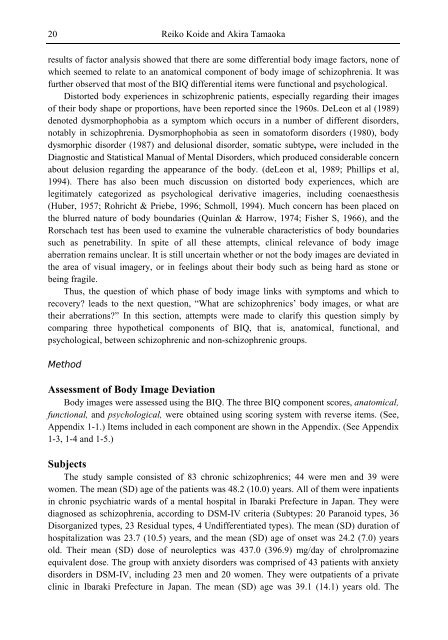Schizophrenia Research Trends
Schizophrenia Research Trends
Schizophrenia Research Trends
- No tags were found...
Create successful ePaper yourself
Turn your PDF publications into a flip-book with our unique Google optimized e-Paper software.
20Reiko Koide and Akira Tamaokaresults of factor analysis showed that there are some differential body image factors, none ofwhich seemed to relate to an anatomical component of body image of schizophrenia. It wasfurther observed that most of the BIQ differential items were functional and psychological.Distorted body experiences in schizophrenic patients, especially regarding their imagesof their body shape or proportions, have been reported since the 1960s. DeLeon et al (1989)denoted dysmorphophobia as a symptom which occurs in a number of different disorders,notably in schizophrenia. Dysmorphophobia as seen in somatoform disorders (1980), bodydysmorphic disorder (1987) and delusional disorder, somatic subtype, were included in theDiagnostic and Statistical Manual of Mental Disorders, which produced considerable concernabout delusion regarding the appearance of the body. (deLeon et al, 1989; Phillips et al,1994). There has also been much discussion on distorted body experiences, which arelegitimately categorized as psychological derivative imageries, including coenaesthesis(Huber, 1957; Rohricht & Priebe, 1996; Schmoll, 1994). Much concern has been placed onthe blurred nature of body boundaries (Quinlan & Harrow, 1974; Fisher S, 1966), and theRorschach test has been used to examine the vulnerable characteristics of body boundariessuch as penetrability. In spite of all these attempts, clinical relevance of body imageaberration remains unclear. It is still uncertain whether or not the body images are deviated inthe area of visual imagery, or in feelings about their body such as being hard as stone orbeing fragile.Thus, the question of which phase of body image links with symptoms and which torecovery? leads to the next question, “What are schizophrenics’ body images, or what aretheir aberrations?” In this section, attempts were made to clarify this question simply bycomparing three hypothetical components of BIQ, that is, anatomical, functional, andpsychological, between schizophrenic and non-schizophrenic groups.MethodAssessment of Body Image DeviationBody images were assessed using the BIQ. The three BIQ component scores, anatomical,functional, and psychological, were obtained using scoring system with reverse items. (See,Appendix 1-1.) Items included in each component are shown in the Appendix. (See Appendix1-3, 1-4 and 1-5.)SubjectsThe study sample consisted of 83 chronic schizophrenics; 44 were men and 39 werewomen. The mean (SD) age of the patients was 48.2 (10.0) years. All of them were inpatientsin chronic psychiatric wards of a mental hospital in Ibaraki Prefecture in Japan. They werediagnosed as schizophrenia, according to DSM-IV criteria (Subtypes: 20 Paranoid types, 36Disorganized types, 23 Residual types, 4 Undifferentiated types). The mean (SD) duration ofhospitalization was 23.7 (10.5) years, and the mean (SD) age of onset was 24.2 (7.0) yearsold. Their mean (SD) dose of neuroleptics was 437.0 (396.9) mg/day of chrolpromazineequivalent dose. The group with anxiety disorders was comprised of 43 patients with anxietydisorders in DSM-IV, including 23 men and 20 women. They were outpatients of a privateclinic in Ibaraki Prefecture in Japan. The mean (SD) age was 39.1 (14.1) years old. The
















